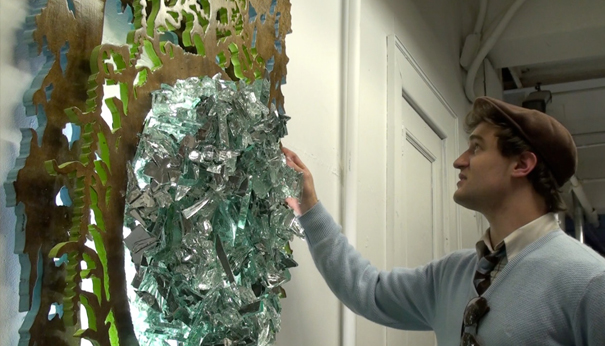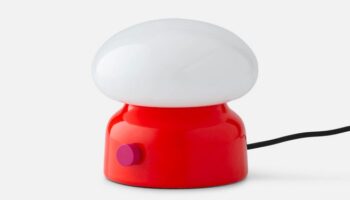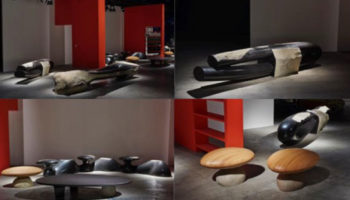Max Glaser Interview Part 1: From Broken Glass and Dances of Light to a Collapse in the Dead of Night
With a name like Max Glaser, it certainly seems apropos that the medium of his fancy is glass. Whether wall-mounted, floor-bound or freestanding, Glaser employs both clear and mirrored glass, usually as the main event, in all his recent works in his West 23rd Street SVA studio. You could say he is a "glacière"; one who works with glass. Actually, that's a phrase I'm coining for my purposes which really means "cooler" in French, but you get the idea. The man loves glass and like he says, "the streets of New York are literally littered with this stuff and if you have the eye, you can find tons of it."
Mirror. Design by Max Glaser.
And he does have the eye as well as the work ethic. He spends his days adhering small broken shards into intricate coral reef-like structures the size of an ac-unit, into a fractal prism mass on the floor, or around unbroken mirrors mounted on the wall with the additional ornamentation of jig-sawed wooden frames. Glaser orates in his studio: "I was living on ramen noodles and glue. Breathing in this industrial strength glue and breathing out structure...and I came into my studio and overnight, it had toppled," referring to a piece in which he'd invested countless hours, adhering small, smaller, bigger, longer, jaggety-er, broken shards of mirrored glass together in conscientious layers to create an organic, amorphous, body-sized coral-reef of a three-dimensional form that no longer exists beyond his own memory and "shitty" camera phone pictures, before it toppled to the floor. What kind of artistic Duchampian madman embraces his own failures to such an extent that he then begins to re-envision the failed piece as something destined to exist, or to even to be reborn, on the floor of his studio, as a monument to gravity? Or even better, as a monument to the human imagination that seeks to extend itself beyond physics and then finds joy in adaptation to the physical world that restrains it?
He grew up in Atlanta, Georgia, and attended an orthodox Jewish High School. Before making the decision to apply to studio art graduate programs, he wanted to be a rabbi. The charisma Glaser exudes cannot be denied. At twenty-six, he is a whirlwind force of creation and articulation. In a city that can be at times isolating and impersonal, he is a relief, a vacation, and dare I say, an inspiration: "I want to create magic in the world. I want people to say, 'Wow, this world is more magical than I thought.'" I expressed my inclination to stick my face into one of his wall-pieces and was excited to learn that was his exact intent explaining that one already sticks one's face into mirrors; "We stick ourselves into mirrors." The piece was an ovular mirror surrounded by jagged, broken glass shards that make a face-sized impression for the viewer to insert the face. I would even go so far as to say that in order to experience the piece fully, one must put the face into it, into the mirror. Despite the seeming violence and agitation involved in the making of such a piece, Glaser's finesse of the material invites the face in to be encompassed and surrounded by self-reflection in a way that no other mirror has ever accomplished, and even denies. The elaborate wooden frames made from his own handy-work and the light emanating from behind, adds to the allure of this prospect.
He cradles one of his abstract coral reef-like works, which in my opinion are the most breathtaking pieces in his oeuvre. These should be viewed from all sides, under, over, around. He explains the tiny pieces of glass he adheres like jeweled building blocks into these intricate forms, as "atomized" pieces of glass that are then reconstituted into an organic structure. Drawing a connection to the reef-like nature of Judaism, Glaser explains that it begins with a flat surface, a foundation, and then is defined and redefined by each generation or community until it ultimately fans out into a beautiful and complex crystalline formation, or as he says, knowingly inventing a word, stalactitic.
For an artist that uses the mirror as a primary material, he seems reticent to talk about self-reflection as his subject matter. Regarding the wall-piece, he explains the fractured glass is meant to play with space, to both destroy, and occupy it. The piece that has no found itself re-envisioned on the floor, formed over a fluorescent light, is less about space and more about light: "I wanted to show the dance of light. How glass gives form to light and to the absence of light. It's a process of occluding and exposing this light, letting it pass through, letting it go around...I think this piece gives over the nature of glass." The combination of both clear and mirrored glass of seemingly infinite shapes and sizes provides a vessel for the bright light from underneath to travel through, be obstructed by, or culminate with to produce varying intensities of aquamarine. The inevitable Robert Smithson parallel can be drawn. Both have an interest in the process of sand to glass and how that can remembered in a work. Max knows glass to have come from "silica particulate" (sand) to some liquid form and then to glass, admitting he doesn't know the entirety of this process, rather, he seems more interested in enacting his own interruptions and processes. He concludes, "I think there is a way a successfully finishing this piece. It ultimately might involve an element of water." Water, glass, and light, what more does one need?







Leave a Reply